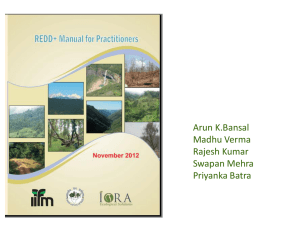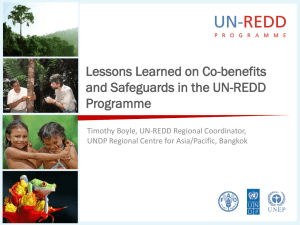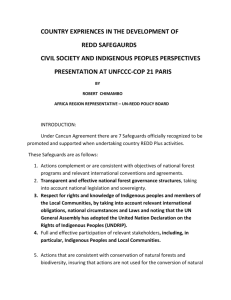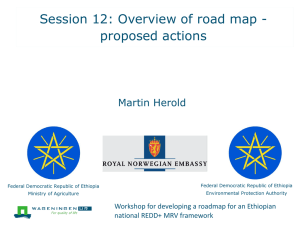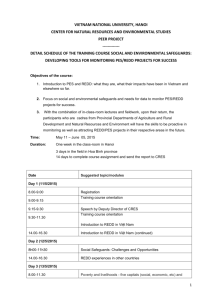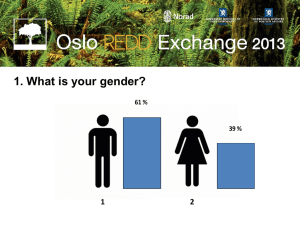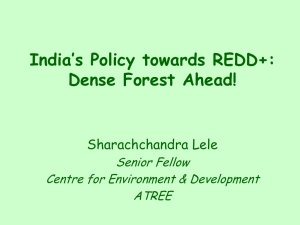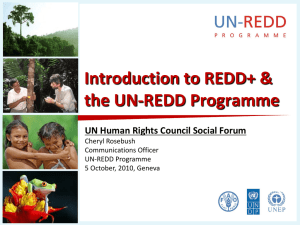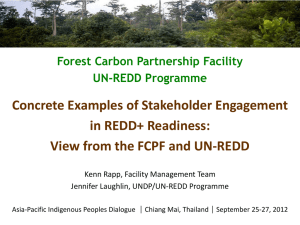Presentation
advertisement
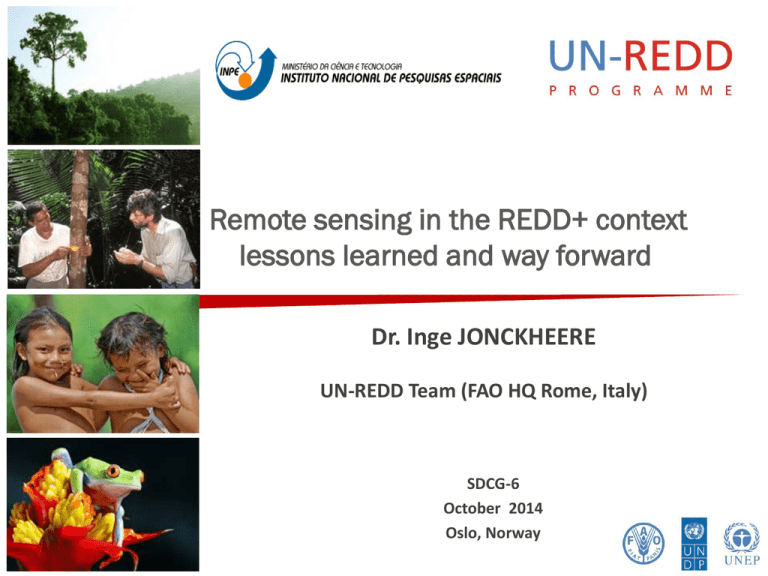
Remote sensing in the REDD+ context lessons learned and way forward Dr. Inge JONCKHEERE UN-REDD Team (FAO HQ Rome, Italy) SDCG-6 October 2014 Oslo, Norway MRV: Measurement The IPCC’s methodological approach to calculate anthropogenic GHG emissions by sources and removals by sinks related to forest land. Information, Monitoring and MRV Development through the 3 REDD+ Phases REDD+ PHASES Phase I Year 2 Year 3 REDD+ Safeguards Information System Capacity building & development - Positive incentive for verified performance - Implementation of P&Ms and demonstration activities - Readiness - Development of P&Ms Year 1 Phase III Phase II Monitoring System SLMS Year ... Year ... Year ... REDD+ Safeguards Information System Monitoring System SLMS: AD NFI: EF GHG-I: CO2e MRV System Year ... Forest monitoring system : Brazil • PRODES – Amazon Deforestation Monitoring Project (Annual Deforestation Assessment) • DETER – Near real-time Deforestation Detection with MODIS (Support for Law Enforcement for Deforestation Control) • DEGRAD – Amazon Degradation Monitoring Project • DETEX - Selective logging activities • TerraClass - Land use monitoring of deforested area (2008) www.dpi.inpe.br/prodesdigital/prodes.php Remote Sensing support UN-REDD • Lots of requests: both NP and TS in three regions • OpenForis widely used in-country Launched in IUFRO: www.openforis.org • Use of global products and linkages with other initiatives (WWF, GFOI, WRI, USAID, Silvacarbon) • Other tools and software mostly country-tailored/dependent • So far optical data, considering radar •Strong link with INPE/CRA • In-country trainings and central trainings in Rome and Belem • Coordination and collaboration for RS capacity building • Use of Methods and Guidance document (MGD) of GFOI as standard RS using MGD document • Easy-to-understand language and exercices package: no one fits all approach • Overview methodologies and data requirements for RS using OpenForis and other open source initiatives • Advantages and disadvantages methodologies • Use of global products and linkages with other initiatives (WWF, WRI, USAID, Silvacarbon) • Coordination and collaboration for RS capacity building • Manual can be downloaded at www.gfoi.org Issues and plans • Coordination with in-house activities: channeling of requests • Prioritization of country support: selection and minimal criteria? • More user-friendly version of OpenForis needed and on its way • Follow-up in-country • Sustainability of training/trainees • LCCS and data accuracy assessment • Use top-down approach vs bottom-up • Link with SDMS (Space Data Management System project) Processing chain: FRA RSS,FAO-FIN,UN-REDD collaboration FAO FRA RSS LC/LU sample sites checked by regional experts OpenForis tool kit Pre-processing Segmentation Supervised classification Edition in TA RS data used in countries • RS data (mainly satellite data) used in -training: both in-country, HQ and INPE (so free access needed) -AD: forest area detection (changes) -NFI design (multisource inventory design and stratification) -Other: R(E)L, Location of households for surveys (HR), Use of HR for field plot location, Mapping of co-benefits, Biodiversity mapping • Main RS data needs from countries: -time series needed (historical data? Sensor interoperability?) -data availability and cost analysis -data acquisition (actual purchase) -data preprocessing -data processing -generation of statistics -accuracy assessment: using national and global products -web dissemination Methodologies and technology for NFMS and MRV z Countries require easy and inexpensive access to technology and tools to develop their NFMS Experience Access to technology is sometime quite limited, particularly for remote-sensing technologies and data The basics are often missing (e.g. steady electricity, high-speed internet, performing computers, software packages) Certain technologies are costly (e.g. HR images, Lidar wall-to-wall, commercial software packages), limiting large-scale deployment and sustainability FAO Forestry Lessons learned Not promote specific tools/data sets but provide overview of available options Help governments make informed decisions Support country decisions and tailor best available approaches while maintaining consistency and comparability of results Heavy reliance on complex & costly technology may not be in all developing countries’ best interest Open source, free software and data set that meet REDD+ requirements are available. If not, new tools can be developed What we’ve learned • A few dedicated individuals can make all the difference – Use of international advisors hand-in-hand with national technicians • Need to see capacity building in broader terms – Training of resilient national institutions and consultants – Mandate of institutions should be clear • Integration NFI and RS • On-the-job training is key – Trainings are geared towards producing results – Essential to get faster delivery • Sharing data and data access is crucial and key • Near-real time monitoring for early warning (e.g. Global Forest Watch), not for reporting • Resilience is often at risk – Easy to develop quickly elements of NFMS, but resilience will be lacking – Long-term commitment is required by government and partners in order to secure sustainability Thank you for your attention! Contact: inge.jonckheere@fao.org www.un-redd.org www.openforis.org

